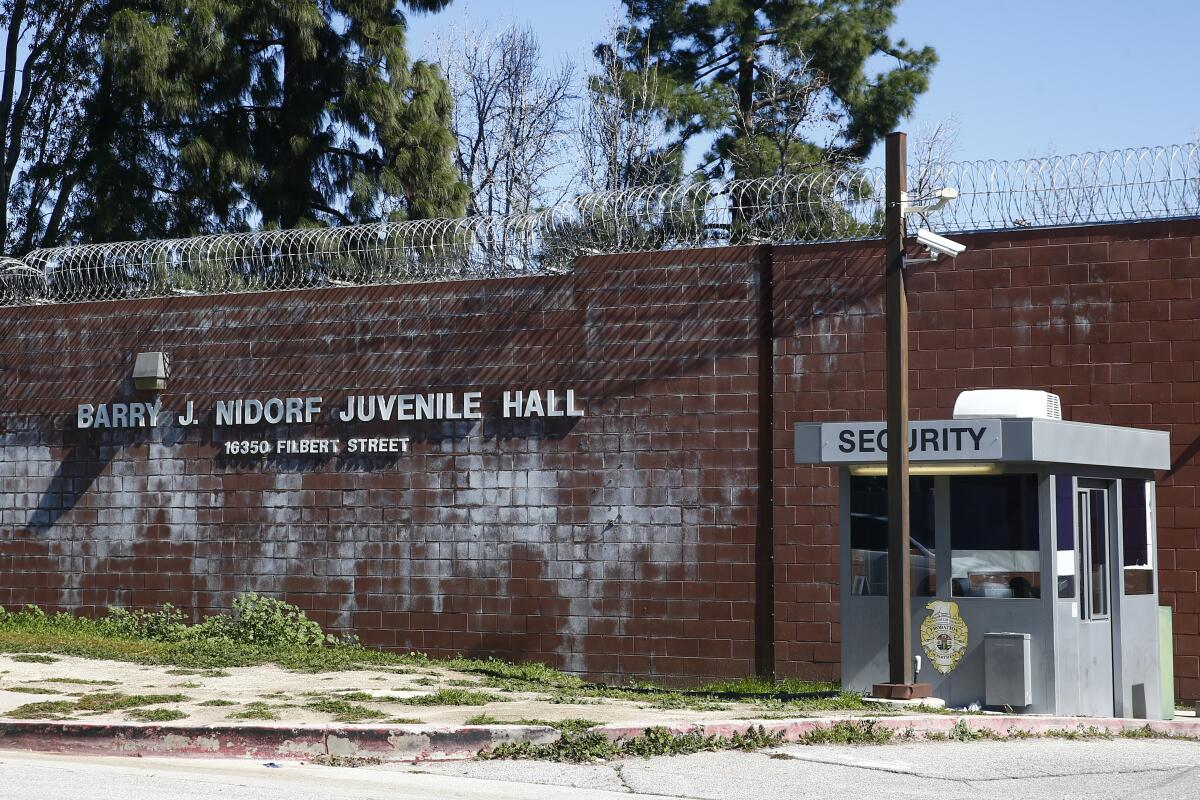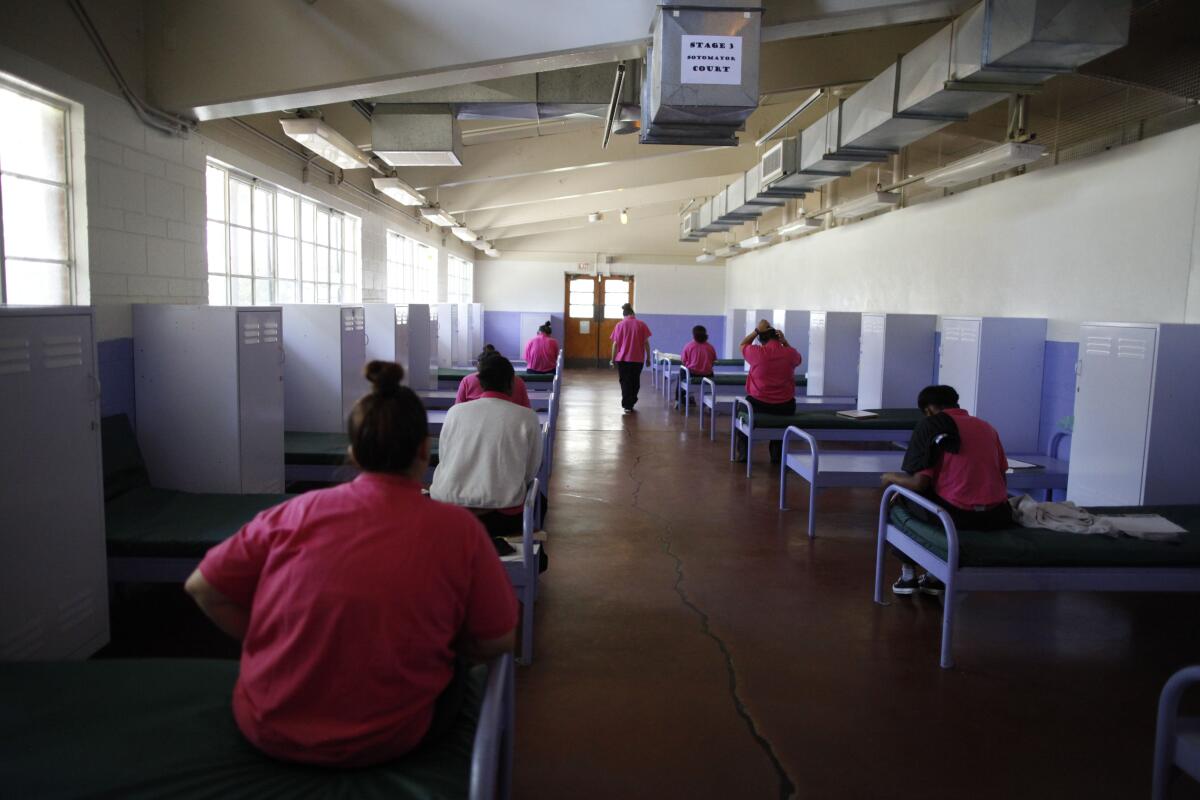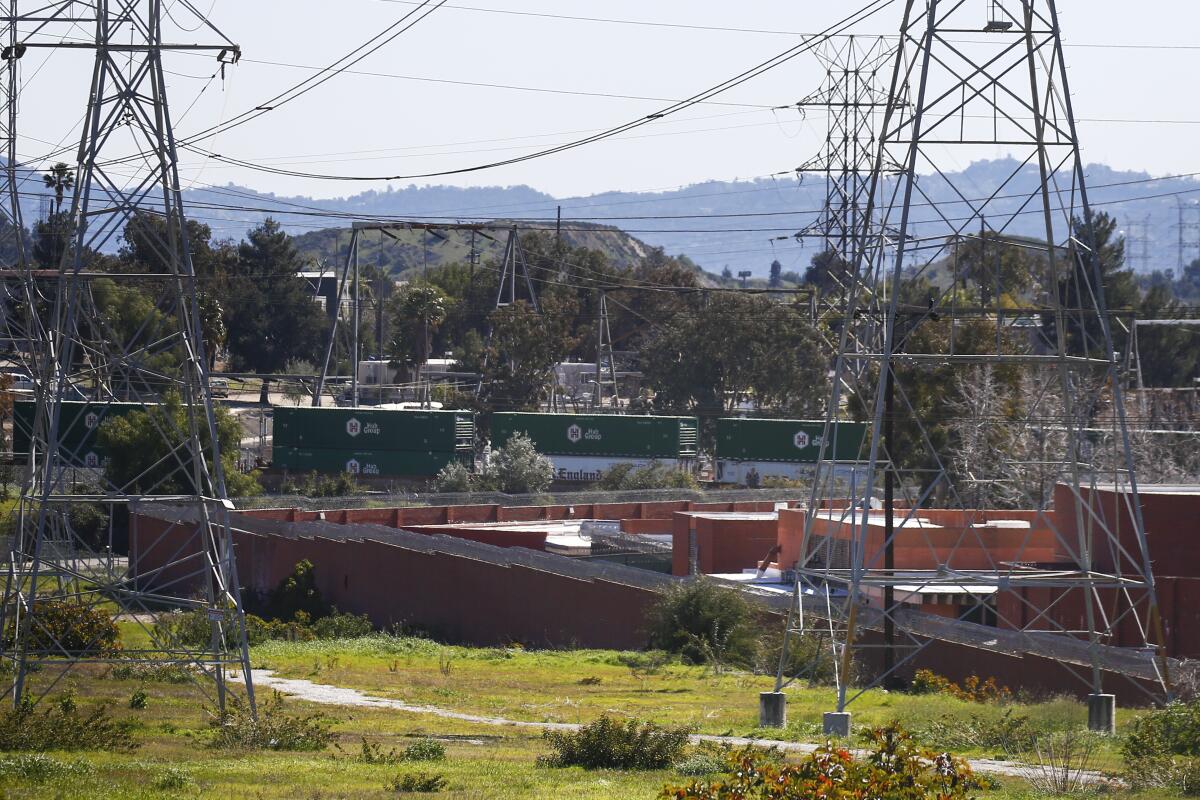Critics of plan to relocate youths from L.A. juvenile hall increasingly vocal before move

- Share via
A plan by the Los Angeles County Board of Supervisors to move juvenile offenders to a probation camp in a remote area of Malibu has run into increasing opposition, amid a broader debate about what the county’s youth justice system should look like.
The first juveniles were set to be transferred to Malibu’s Camp Kilpatrick on Sunday, but the county Probation Department decided at the last minute to postpone the move because security enhancements at the facility have not yet been made, officials said.
Plans call for gradually moving most of the youths housed at the troubled Barry J. Nidorf Juvenile Hall in Sylmar to three smaller camps across the county: Kilpatrick, Camp Scott in Santa Clarita and Dorothy Kirby Center in Commerce. Under the county plan, male offenders will be housed at camps Kilpatrick and Scott, while female offenders will be at Camp Kirby.
Of the three facilities, the only one ready to receive youths is Kilpatrick, which was envisioned as a more humane approach to juvenile justice, including using smaller dorms instead of the military-style barracks found at probation halls like Nidorf.
But an uproar over the move started almost immediately after the county Board of Supervisors’ 4-1 vote in March.
The only dissenting vote was cast by Supervisor Kathryn Barger. Barger introduced a counterproposal in March to convert Nidorf into a centralized youth facility. Nidorf failed an inspection in March when it was revealed that youths were being held in isolation longer than necessary.
Barger’s proposal was rejected at a March county supervisors meeting, but it has gained traction in recent weeks in Malibu and in Santa Clarita, where officials sued to block necessary renovations at Camp Scott before the facility could reopen.
The suit argues that the 120-bed camp, which housed female offenders before it was closed in 2020, is not a suitable location because it sits in high-fire zone that’s also downstream from a nearly century-old dam, which city officials say could break and flood the area.

Officials there have also argued that the plan for housing juvenile offenders at Scott contradicts experts from the Probation Department. An earlier probation assessment concluded that Nidorf was the most appropriate setting for lawbreaking kids because of its size and central location.
In Malibu, talk of the pending move dominated a recent virtual meeting of the Las Virgenes-Malibu Council of Government. Speakers expressed concern about the placement at Kilpatrick of so-called “secure track youth” who have have been convicted of serious offenses.
Previously, those young offenders would have been housed at state youth prisons, but the Division of Juvenile Justice, beset by decades of scandals, is scheduled to be shut down in the summer of 2023 under a state law passed last year and a budget directive issued by Gov. Gavin Newsom. Until recently, Los Angeles County sent kids convicted of more serious crimes to state prisons; now they’re being held closer to home.
And that has left counties with the tricky task of figuring out what to do with youths convicted of murder and other serious felonies while simultaneously downsizing juvenile halls and camps.
Nestled in an unincorporated part of Malibu in the Santa Monica mountains, Kilpatrick reopened in 2017 after a $53-million makeover. Save for the tall fence that wraps around its exterior, the place at first glance looks more like a small college campus than the detention facility it is. And that’s the point, proponents say.
At the time of its opening, it was seen as a testing ground for the so-called L.A. Model, which uses small-group settings and focuses on emotional support, counseling and treatment. The approach takes into account any trauma that may have contributed to behavioral problems instead of thrusting youths into a boot camp-like regimen of discipline.
But a report published early last year found that, while the facility showed some promising signs, the L.A. Model was never properly implemented there.
Malibu City Councilman Mikke Pierson said residents never had a chance to formally weigh in on the plan to expand Camp Kilpatrick. He also said that, while he “completely believes in rehabilitation and redemption for human beings in general,” the decision to start moving juveniles to Kilpatrick was rushed “because of the reaction that they got in Santa Clarita.”
“It doesn’t feel very well thought out at all,” he said in a recent interview. While some residents had suggested following Santa Clarita’s lead in taking legal action, Pierson said that was unlikely. Still, he said, “I don’t think our conversation on this is over.”
In February, the union that represents the county’s rank-and-file probation officers sent a letter to Pierson warning about the “recent plans lead by special interest groups that can have adverse consequences to the safety and the lifestyle of Malibu residents.”
“The City of Malibu with all its prestige and glamour does not need such resident roaming their streets,” the letter read. “A mistake in supervision, and unfortunately mistakes happen and are often due to inexperienced staff, can result in the escape of a 25-year-old serious, violent, sexual offender out in the streets of Malibu committing ungodly and unthinkable acts.”
In the months since, several Malibu officials have echoed those concerns publicly.
The Probation Department, which operates Kilpatrick and other juvenile detention facilities, did not respond to a request for comment.

Hans Liang, president of the probation officers union, AFSCME Local 685, said earlier this year that the Probation Department released a detailed proposal that recommended turning Nidorf into a secure youth facility. He said he had serious concerns about the safety of staff and detainees at Kilpatrick, citing recent violent run-ins at other probation-run facilities.
“You have cottages, you have freedom of movement,” he said. “One of the big issues that we have is that we want to engage in the programming … but before you have control you can’t even do that, especially if the kids are finding ... they can cause disturbances.”
But Supervisor Sheila Kuehl, one of the board’s staunchest champions of the relocation plan, said that the county made no secret of its intentions. She accused the probation officers union of whipping up public fear with inflammatory rhetoric that evoked the tough-on-crime era of the 1990s.
Juvenile offenders will be housed at camps in Malibu, Santa Clarita and Commerce, supervisors decide
Supervisor Holly Mitchell said the move reflects a philosophy of rehabilitating young offenders over a punishment-based system.
“What they’re saying is they’re putting young people in a camp off in the mountains, and we’re worried that they’re going to all escape and run down to our houses. And so we should get a say,” said Kuehl, whose district includes Malibu.
“Do we give cities a vote about whether there should be any facilities in their district?” she asked. “And if we did, do we think that there would ever be any jail, or juvenile halls anywhere?”
Kuehl and others have argued that the conditions at Nidorf are “prison-like” and unsuitable for prolonged housing. A week after about 140 youths were hastily transferred to Nidorf from the equally troubled Central Juvenile Hall, state inspectors found the facility again in violation of a corrective action plan.
That plan had been enacted by the Board of State and Community Corrections after the oversight agency found the county’s juvenile halls were unsuitable to house youths last year.
She said there are only nine youths currently staying at Kilpatrick; the plan is to start by moving a handful of juveniles there from the roughly 140 that are being housed at Nidorf.
The relocation plan also has drawn broad support from prison reformists. Patricia Soung, an independent consultant on juvenile justice, said this kind of hand-wringing accompanied previous efforts to overhaul the state’s youth prison system, which as recently as the mid-2000s incarcerated roughly 10,000 juveniles, she says.
She said she believes that some of the public backlash is “laced with pretty racist notions of both who the young people or their families are.”
Soung serves on the county Juvenile Justice Coordinating Council. She said she blames some of the opposition on a lack of basic information from the Probation Department about how facilities such as Nidorf and Kilpatrick are operated.
“The nature of the offenses for which young people are committed to secure track are not that different from those that were committed by young people who’re currently housed” at Kilpatrick, she said.
Some criminal justice advocates worry that the ongoing debate distracts from the need to fund community-based alternatives for dealing with people who’ve been convicted of certain crimes — particularly youths, whose brains, research has shown, don’t stop developing until age 25.
According to a 2021 Probation Department report, Kilpatrick on average tended to house older kids who had spent more time locked up than their peers at other facilities and a high percentage of juveniles who were deemed high-risk. But it had lower rates of youth-on-youth violence than the other camps.
Perhaps most promisingly, only 56% of youths who were released from Kilpatrick had further involvement with the adult justice system, although the study’s authors cautioned that their efforts were hampered by inconsistent data. Recidivism studies show that youths reoffend between 40% and 65% of the time after being released from juvenile facilities.
But the report also raised some red flags, saying that, after briefly relocating to another facility in the wake of the devastating Woolsey fire in 2018, the facility lost 30 staff members and was forced to rely on probation officers who hadn’t been trained in the L.A. Model.
County officials hired DLR Group, the same architectural firm that designed Kilpatrick, to study the restoration of Scott in Santa Clarita. In a preliminary report, the firm suggested possible upgrades, including erecting a new security wall around the camp’s north and west boundaries, and upgrading the existing dorms, administrative building, gymnasium and dining hall and potentially building a new medical clinic.
Whether that work will continue as the city’s lawsuit wends its way through the courts remains to be seen. In a March 12 letter to the Board of Supervisors, Santa Clarita officials wrote that the camp’s “dilapidated conditions, historical use as a camp, and closure since March 2020 offers very little, if any, of the necessary amenities and infrastructure needed to adequately protect and rehabilitate juvenile serious offenders.”
Any repairs would be cost-prohibitive, the letter added.
When Kilpatrick opened in its current incarnation five years ago, Jorja Leap, a professor at the UCLA Luskin School of Public Affairs, co-authored a brief extolling the promise of taking a therapeutic approach to juvenile rehabilitation. Five years later, her confidence has wavered somewhat.
“The real problem is that that promise of trauma informed care … has not been completely fulfilled,” she said, attributing some of the lack of progress to resistance by some at the Probation Department who were unwilling to let go of the “get tough” approach of the past. “And this is something that is a deep concern to me, because the culture of Probation must be changed.”
More to Read
Sign up for Essential California
The most important California stories and recommendations in your inbox every morning.
You may occasionally receive promotional content from the Los Angeles Times.












